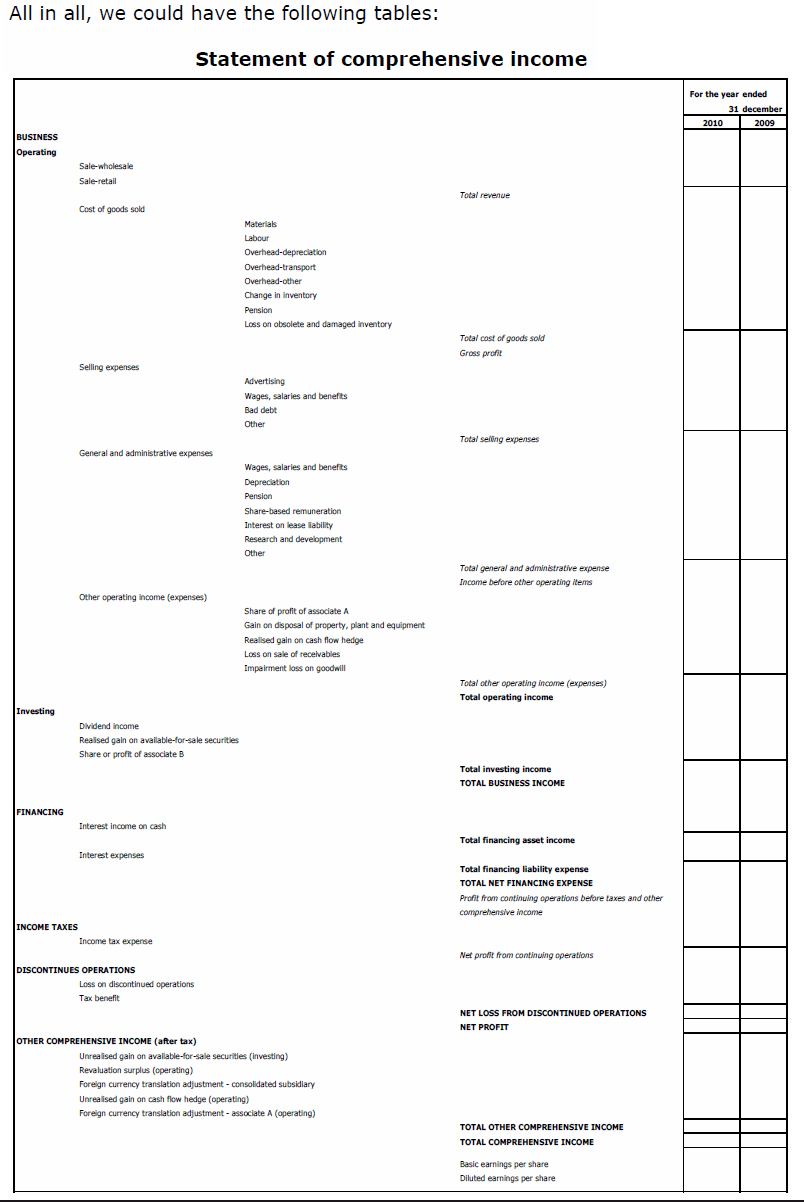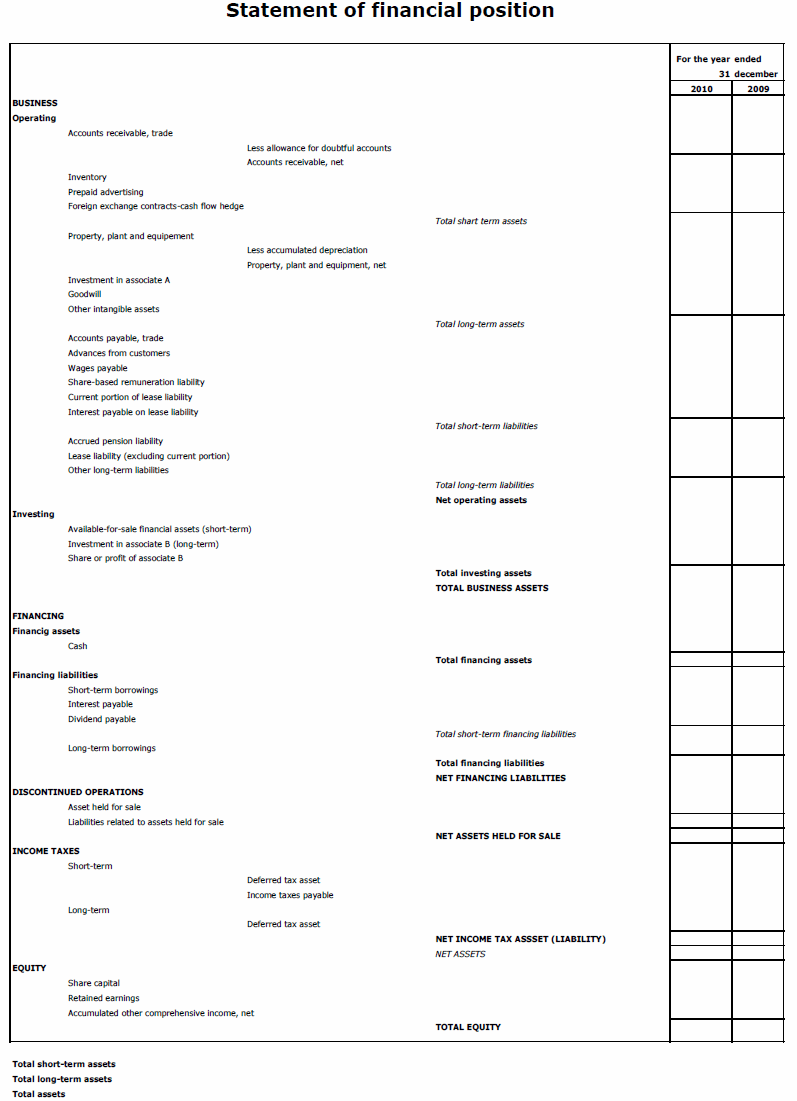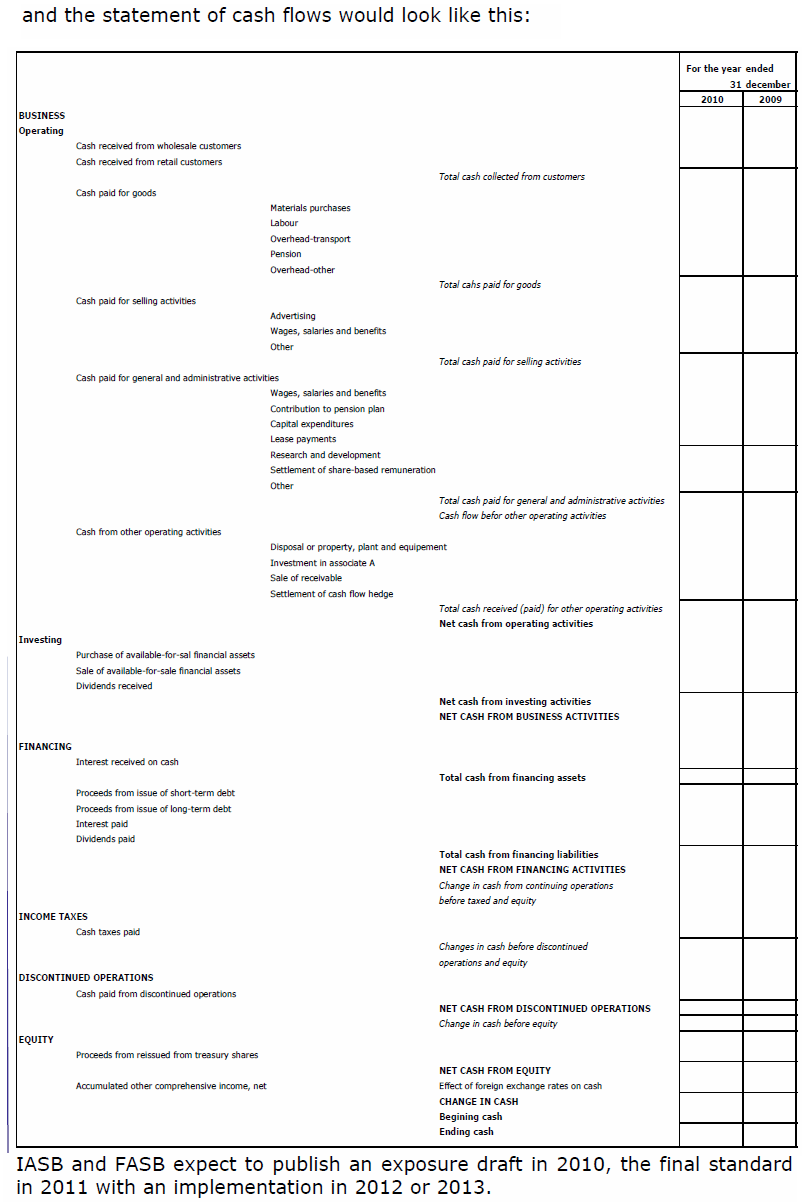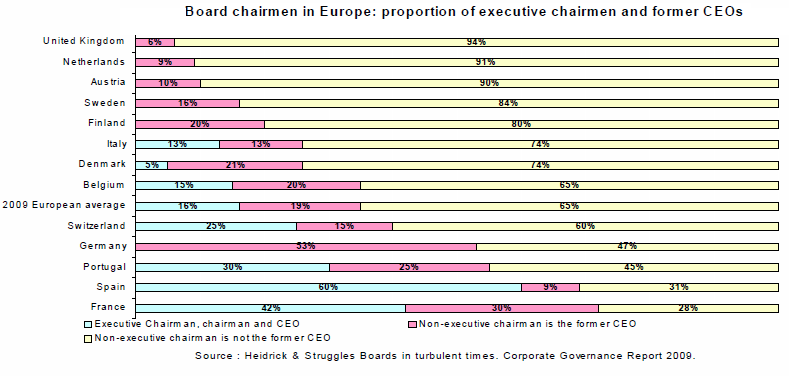Letter number 41 of May 2009
ALL ARTICLES
- TOPIC
- STATISTICS
- RESEARCH
- QUESTIONS & COMMENTS
News : NEWS: Working towards change in the presentation of financial statements
In October 2008, as part of their convergence project (1), the IASB and the FASB published a discussion paper on the presentation of financial statements with the aim of soliciting comments from interested parties by April 14, 2009.
At the risk of being accused of being backward-looking, we don't see any urgent need to change the way financial statements are presented, either in our daily work as investment bankers or as teachers of finance. One of the great merits of accounting is that it is simple and understandable by all, which is what gives it its legitimacy. Many would admit that recent changes, even before the advent of IFRS (for example the generalisation of deferred taxes (2)) have made financial statements less easy to read.
Will this trend be reversed by a new presentation of financial statements? We have our doubts.
We know that the international standards had little to say about the way financial statements are presented, which is what led some national accounting regulator in their time to publish an extremely useful and very widely followed recommendation on the presentation of income and cash flow statements.
The main suggestions of the IASB and the FASB include:
- a clearer separation between the company’s operational activity and its financial activity, following on the system that was adopted a long time ago by financial managers in terms of valuation (discounting free cash flows, operating aggregate multiples), choice of investment (NPV, IRR), and performance monitoring (ROCE, EVA, etc.). The balance sheet could clearly show capital employed (working capital + fixed assets) financed by equity and net debt, no longer just a split between assets and liabilities;
- a clearer split between debt and equity;
- a cut off point of one year for resources and uses of funds, rather than a split between current and non-current activities, which are more subjective as they are linked to an operating cycle and vary from one firm to another;
- an elegant end to the dilemma of having to choose between a “by nature” presentation for the income statement (personnel expense, purchases of raw materials, etc.) and a “by function” presentation (cost of products sold, marketing costs, R&D costs, etc.) which has not been solved in practice (3). The new format will allow for a simultaneous and direct reading of the income statement according to both approaches.
The more minor points that would be improved upon include:
- the classification of tax credits or liabilities as financing when in our view they should be considered as working capital, and accordingly capital employed (4);
- the presentation of the cash flow statement using the direct method (payments received from customers, payments made to suppliers) rather than the indirect method that is widely used today (accounting aggregate with deduction of adjustments – depreciation and amortisation, change in working capital). The advantage of the new presentation is that it is easy to show free cash flow, without the need, as is the case today, to extract financial expenses included in net earnings, which is the point of departure for many cash flow statements under the existing system. The downside is that we lose the clear explanation, appreciated by the layperson, of how we get from net earnings to cash flow, something that beginners in the study of finance generally find rather complicated;
- the closing of the cash flow statement with “change in cash”, an item that is a lot less stable and less structuring than “change in net borrowings”, which we recommend;
- the inclusion of comprehensive income (mainly change in assets and liabilities booked directly under equity) on the income statement (which becomes a statement of comprehensive income) below net earnings, which, fortunately, does not disappear and remains firmly in place!
- the classification of pension fund commitments as working capital requirement, although these commitments are a form of financial debt (5).
(1) For more details see Vernimmen.net Newsletter number 30, July 2008.
(2) For more details see chapter 7 of the 2009 Vernimmen.
(3) See chapter 3 of the 2009 Vernimmen.
(4) For more details see chapter 4 of the 2009 Vernimmen.
(5) For more details see chapter 7 of the 2009 Vernimmen.
Statistics : Board chairmen in Europe
Can the Chief Executive Officer of a group become its non executive Chairman?
No in the United Kingdom where it is perceived as non politically incorrect for fear that he/she will limit the freedom of his/her successor to change the strategy or even worse interfere in the day-to-day management of the group forgetting that he/she has relinquished his/her executive responsibilities. Most of the time, the chairman of a UK group is a former Chief Executive Officer of an unrelated company who spends 1 or 2 days a week on this assignment.
Yes in France and in Germany where his/her expertise and ability to advise the CEO he/she has frequently chosen and groomed is highly valued. In France, the separation of the two roles (non executive chairman, chief executive officer) is often temporary (Total, Renault) allowing the newly appointed chief executive officer to demonstrate that he/she is up to the job. Subsequently, he/she is appointed as chairman and CEO, but there are examples (Axa) where this is not the case.
Research : Do bankruptcy code matters ?
There is no shortage of academic research on the consequences of the legal environment of a given country on its financial system. In the last edition of this Newsletter, we looked at an article showing how the terms of bank loans vary, depending on the legal traditions of the country in which they are granted(1) . This month we look at an interesting article that focuses on how debtor default is dealt with in different countries.
The way in which default on payment is managed in different countries modifies the percentage of the debt that creditors (and more specifically banks) are able to recover. Davydenko and Franks look at bankruptcy law in three European countries (France, Germany and the UK) and show that banks seek to tailor their loans to make the most of legislation in force (2). They reproduce the rankings from a now famous article (3) that awarded France the lowest score for creditor protection, compared with a score of 3 for Germany and a maximum 4 points for the UK.
In France, the absolute priority given to keeping the business going and protecting jobs has the side effect of reducing creditor protection. Banks require more collateral – over 100% of the value of the debt (compared with 40% in Germany and 60% in the UK). There is very little use of mortgages as assets tend to be sold off at far below their market value once bankruptcy procedures are launched. Banks prefer personal guarantees that they can activate directly. In the UK, default on payment leads to a procedure in which first ranking creditors have a veto on all decisions made by the directors. This means that first ranking creditors obtain de facto control over the company. In Germany, creditors do not enjoy quite as much protection but are better off than their French equivalents, retaining some power in the restructuring of loans.
Notwithstanding the efforts made by banks to adapt, there is still a huge gap between recovery rates in the three countries, which are 92% in the UK, 67% in Germany and only 56% in France. The results of an econometric analysis of equivalent firms show a recovery rate in the UK that is 20% higher than that in France, which is a considerable difference. Paradoxically, the number of businesses that continue to operate is slightly less in France than in Germany and the UK which means that the laws in place to protect businesses in France are not having the desired effect. Banks in the UK are encouraged to do their best to ensure that firms keep going as they are able to recover more from a going concern.
However, it should be noted that spreads used by UK banks are higher than those used by French banks (16 base points for an equivalent loan). Davydenko and Frank attribute this to less competition between lending establishments, the result of a financial system that is dominated by markets. Moreover, by focussing on firms that have defaulted on their loans, the article fails to analyse the abilities of the three systems to prevent debtor default (such as the "alert procedure” in France). Competition between banks, prevention of debtor default, these are all factors that should be taken into account for a fuller comparison of the merits of legislation in place in different countries in this domain.
(1) For more details see the Vernimmen.com Newsletter n°40, March 2009.
(2) S.G. Davydenko and J.R. Franks (2008), Do Bankruptcy Codes Matter? A Study of Defaults in France, Germany and the UK, Journal of Finance, vol.63, pages 565 to 608.
(3) R. La Porta, F. Lopez-de-Silanes, A. Shleifer and R.W. Vishny (1998), Law and Finance, Journal of Political Economy, n°106, pages 1113 to 1155.
Q&A : Crossword
Horizontal
1. Difficult to keep then constant in the current environment.
2. Tours that take CEOs and CFOs of listed companies to London, Edinburgh, Geneva, Paris, Boston and New York once or twice a year.
3. Provided too much credit enhancement so that most of them are now bankrupt or in bad shape.
4. Only Fidel Castro believes it has a role in the current financial and economic turmoil.
5. Financial divisions that do not create value.
6. Weapon of mass destruction according to Warren Buffett.
7. Has lost his bonus and sometimes his job too.
8. Some countries are lamenting their failure to adopt it as their currency earlier but it’s too late now!
9. If you were ……. on real estate you will have lost a pretty large amount of money!
10. Life would be a lot more serene today if they’d never existed.
11. The opposite of unfair.
12. Return on investment.
13. The yield ….. is now steep, with the right slope to help bankers restore their margins.
14. Could have succeeded in ousting the CAPM but never became very popular with professionals.
15. No longer a bad word, especially in the UK.
16. If you do not ….. , you will not find, except of course if you just stumble onto it.
17. ……. is king.
18. A British economist who married a Russian dancer and who is once again back in favour.
19. 7 usually does more than one per day.
20. You cannot do without it when computing the value of a share using a P/E ratio.
21. Same as definition 7.
22. Finance is all about it.
23. Has considerably increased for car manufacturers since the end of 2008.
24. We now know that it can be plentiful and then vanishes in a matter of days if not hours.
25. Until mid 2007, the sky seemed to be its only limit. Now people are treating it with more caution.
26. You should at least be able to keep it when your house is seized because you have stopped paying your monthly payments on your subprime loan.
27. Have plenty of work ahead of them.
28. Return on assets.
29. Sale of unexercised warrant
30. With 62, one of the two main culprits responsible for the current situation.
31. What most stock prices are now.
32. An option or a phone conversation.
33. Could it did a worse job?
34. They take place once a year, generally at this time of the year.
35. Single Euro Payment Area.
36. There are being progressively replaced by IFRS.
37. If you’re on the dole then you’re not longer on it.
38. This is what the Vernimmen is all about!
39. Earning before interest, tax, depreciation and amortisation.
40. Most non US groups are listed in the USA through them.
41. Adjusted Net Asset Value.
42. In 3 words; the best investment choice criteria.
Vertical
43. Will rise from the dead, just like Jesus did, but it will take more than 3 days!
44. Cannot go bankrupt but has clearly failed.
45. Was very much sought after when markets were up but proved to be illusory when markets turned down.
45 bis. Same as 41.
46. A very regular guy who turned out to be a crook.
47. So are you if you have lost everything on the stock market including your shirt.
48. A booming area.
49. A barbarian relic according to 18.
50. They have so poorly performed recently, especially on structured products, that they have being deprived of their first N. 2 words.
51. The P/E ratio is one of them.
52. When I learned that most of my assets were placed with Madoff, I decided to drown my sorrows by drinking a whole bottle of it!
53. Useful for speculating, hedging or for arbitrages.
54. Widely used to compute the cost of equity or the cost of capital.
55. The one between Daimler and Chrysler was a disaster and ended up being unravelled.
56. A Spanish car trademark or the asset of a stockbroker.
57. The American equivalent of the AMF, CONSOB, CNMV or FSA.
58. If at end of the summer of 2008 you were …… on volatility you made a killing!
58 bis. Entreprise Ressources Planning.
59. Same as 14, created by Stephen Ross.
60. Computed in London and widely used in banking worldwide.
61. Has dramatically increased over the last 18 months but the impact of it increase on borrowers was mitigated by interest rate falls.
62. With 29, one of the two main culprits responsible for the current situation.
63. Cannot be increased forever without increasing risk taken.
64. A worthy successor to Nick Leeson even if he didn’t bring his bank down.
65. Return on capital employed.
66. The option market in London.
67. Measure the market risk of an asset.
68. Companies are always reluctant to cut it but sometimes they simply have to in order to save cash.
69. Same as 51.
70. Has unwillingly illustrated that there may be exceptions to the “too big to fail” rule even if everybody regrets its now.
71. Net Asset Value.
72. Same as 8.
73. No longer as popular with managers as before mid 2007.
74. Some companies are merging to achieve the right ……..
75. A product that allows you to exchange a fixed rate for a floating one, a dollar for a euro, etc.
76. Net Operating Profit After Tax.
77. Most asset managers say they are pursuing it, very few deliver it constantly.
78. If your focus too much on this then you forget all about risk, and you’re are dead.
79. The missing brother of ROI, ROCE and ROA.
80. Can be normal, inverted or flat; 2 words.
81. Return On Equity.
Solution is available on the vernimmen.com website.





